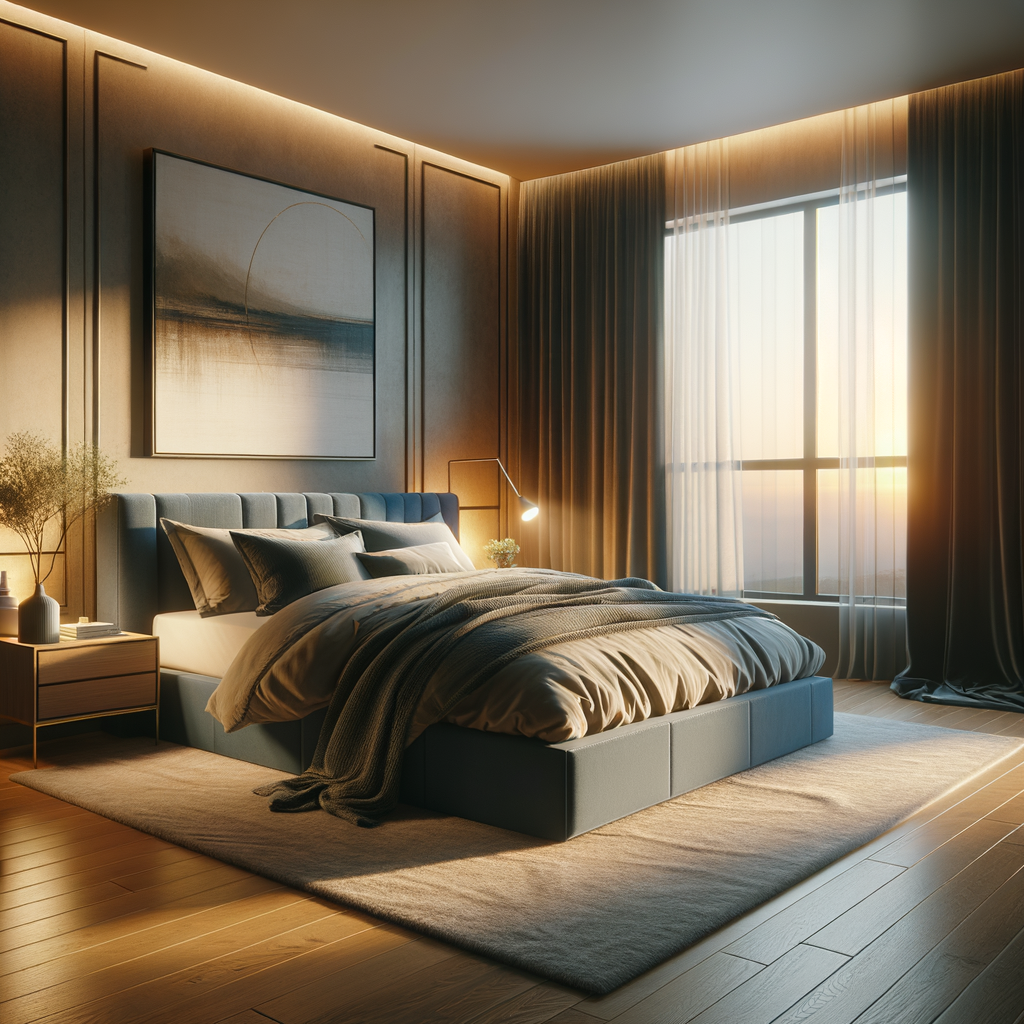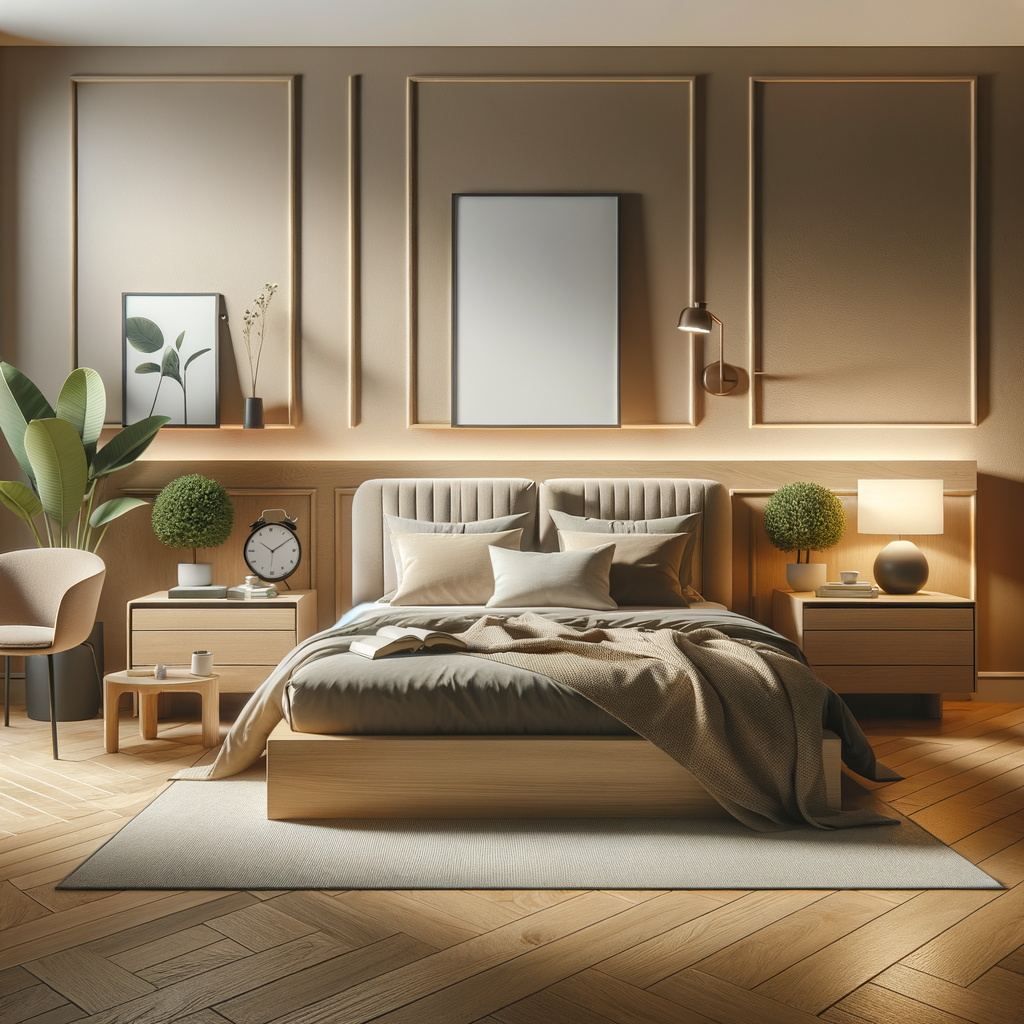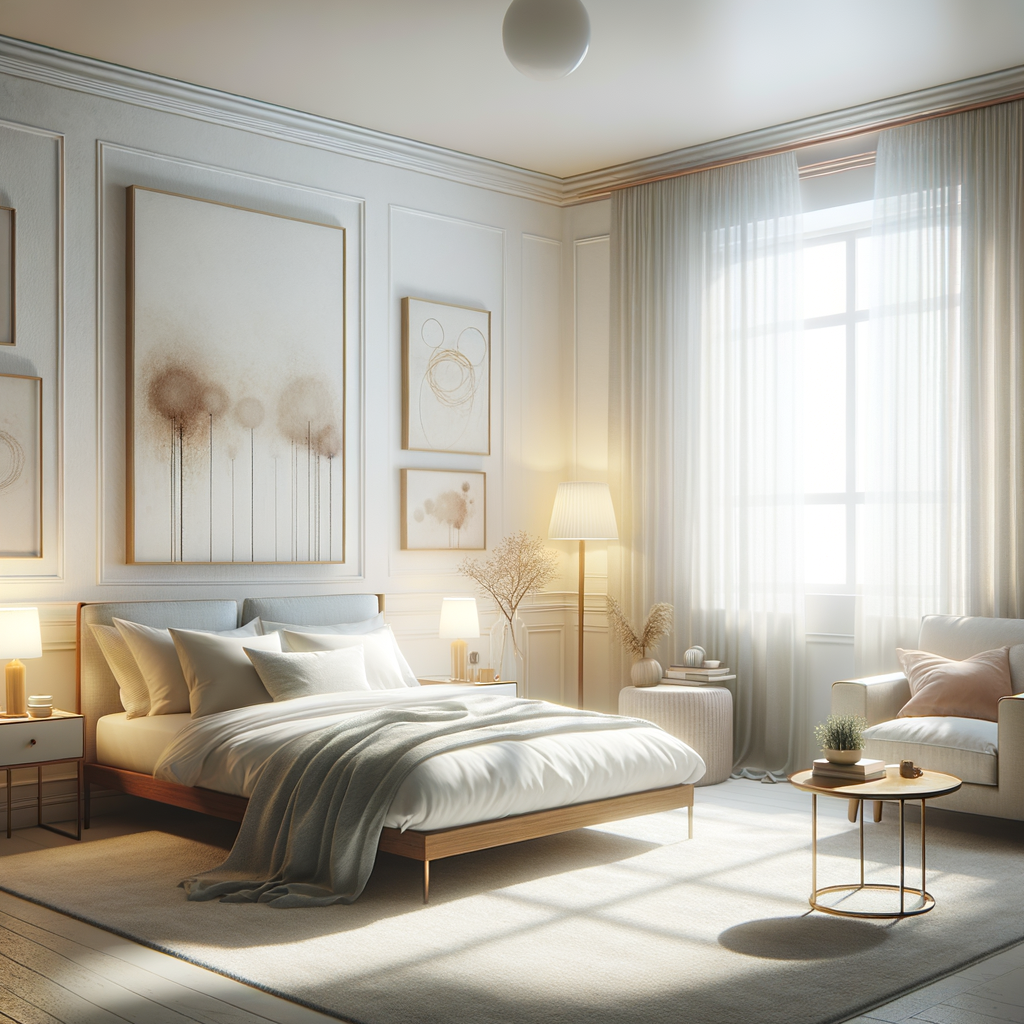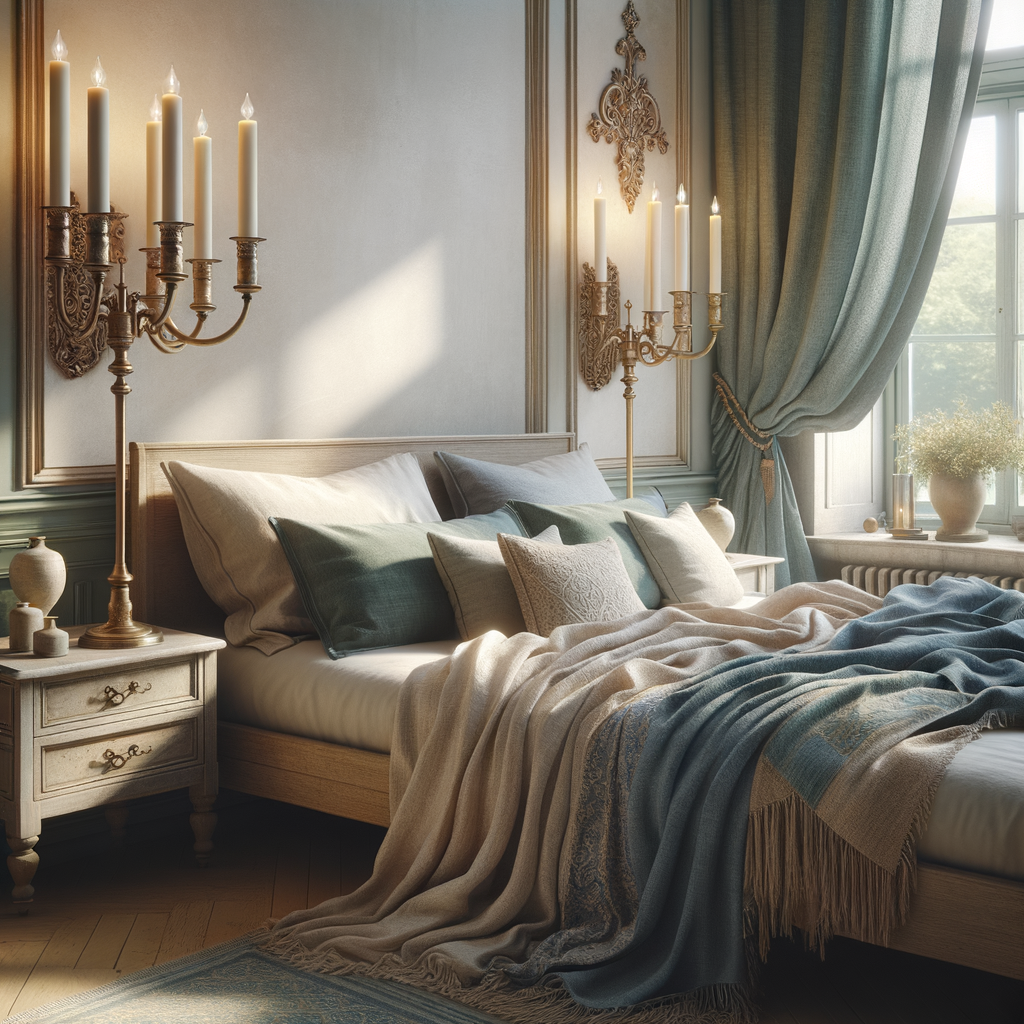In today’s busy world, the bedroom is an oasis we all look forward to escaping to at the end of a long day.
When designing modern western bedrooms, my goal is to incorporate clean, minimalist lines while still making the space warm and welcoming.
Floating nightstands, platform beds, and built-in storage help achieve an open, uncluttered vibe that many of my clients gravitate towards.
Natural materials like wood, stone, and texture add visual interest without overwhelming the simple color palette I tend to favor like crisp whites, muted greys, and calming blues.
Lighting is also important to consider for both function and ambience.
Sconces above the bed and plug-in wall lamps give flexible task and accent lighting without compromising the streamlined look.
Large windows let in views of the outdoors and maximize natural light during daylight hours.
Through careful attention to aesthetics, functionality, and bringing my clients’ individual visions to life, I’ve come to truly appreciate the bedroom as a place not just for sleeping, but for relaxation, recharging, and inspiration.
I hope this modern western bedroom design provides ideas for achieving your own personal sanctuary space.
✨Click to Get My 101 FREE Designer Room Ideas
Platform bed – A clean-lined platform bed is a signature of modern western style. Opt for metal, wood, or fabric-upholstered for texture

Platform beds are a defining element of the modern western style.
Their clean, unencumbered lines give the illusion of more open space in the bedroom.
Opting for a platform bed allows you to showcase beautiful bedding and pillows without the bulk of a traditional box spring foundation.
When choosing materials for a platform bed, metal offers an industrial edge while wood provides warmth.
Look for unfinished hardwood like oak or walnut for a rustic touch.
Fabric upholstery can also work well and adds a tactile element, ideal for leaning against the bed while reading.
Many fabric beds have an internal wooden frame for support.
In terms of dimensions, queen or king platform beds fit well in most space without overpowering it.
Make sure to measure your bedroom to accommodate the bed size plus adequate walking room on all sides for comfort and functionality.
Platform bed frames can be found in different heights.
Generally, standard height is lower to the ground which is easier to get in and out of but may feel closed in.
Upholstered platforms often sit higher for extra cushioning underneath.
Adding storage drawers or boxes beneath the platform provides valuable hidden storage in the bedroom design.
A platform bed allows you to play with textures through your choice of fabric, wood or metal.
Layer on plush pillows and warm bedding in natural fibers like wool, cotton or linen.
This cohesive textile palette helps define the modern western aesthetic in your bedroom.
Floating nightstands – Nightstands with cutout bases that appear to float give the illusion of more space

Floating nightstands have become a very popular design element in modern western bedroom styles.
Their legless, see-through bases create an optical illusion of more open floor space in the room.
This sense of airiness complements the light, unfettered aesthetic commonly seen in this design genre.
In terms of constructing floating nightstands, there are a few main options.
Prefabricated metal or wood nightstands feature cutout square or circular frames that function as tabletop supports.
For a custom look, woodworkers can also build floating bases out of wood strips or beams connected underneath forming an X or H shape structure.
Placing floating nightstands neatly against the wall gives the perception that the tables are just hovering without touching the floor.
Make sure to properly anchor floating furniture to the wall for safety, especially if placing lamps or other items on top that could be knocked over.
The transparent bottom of floating nightstands allows the bedroom design elements behind like wall color or art to peek through for a cohesive appearance.
Opt for tabletop surfaces ranging from wood, marble or travertine depending on your style preference.
By choosing nightstands with open bottoms, they add visual lightness to the bedside without overwhelming the space.
This feeling of openness and flow helps characterize modern western bedroom aesthetic using floating furniture elements.
Built-in storage – Opt for storage nooks, cabinets, or open shelving built into the walls for a seamless look

Built-in storage is a practical and visually pleasing element of the modern western bedroom aesthetic.
Rather than bulky furniture pieces, built-ins utilize unused wall space and make the most of every square inch.
Floating or semi-recessed cabinets provide enclosed storage for items like linens or out-of-season clothes.
Opt for paneled or glass doors depending on your style.
Recessed wall shelves create defined spaces to corral books, photo displays, plants or decorative accents.
Floor-to-ceiling nooks also double as headboards.
Deep drawers allow you to neatly stash extra blankets or out-of-the-way knickknacks.
Make them wide enough for folded items.
Floating horizontal shelves are perfect for displaying treasured items, books, plants or removing excess clutter.
Make shelves extra deep for dual use.
Built-ins lend themselves well to natural wood finishes like light oak, walnut or reclaimed wood for a warm, rustic feel.
Integrate lighting underneath or beside wall units for functionality.
Consider electrical outlets within or nearby storage spaces.
With built-ins, the storage merges with the backdrop seamlessly instead of protruding furniture.
This crafted, customized approach is tailored to each bedroom nook and cranny.
Built-ins allow you to really maximize every square foot!
White or light-colored walls – Crisp whites, light greys, or pale blues are calming color choices

Light, neutral wall colors are very common in modern western bedroom design because they help create a relaxed, spa-like atmosphere.
Crisp whites, pale greys, and soft blues all make the space feel bright, spacious and serene.
Some benefits of light wall colors include:
- They make the most of natural light.
Light walls reflect daylight throughout the room for an airy feel.
- They are versatile.
Neutral walls pair well with a variety of bedding colors and patterned accents over time.
- They feel calming.
Pale shades are psychologically soothing and promote better sleep.
- They minimize visual clutter.
Lighter walls downplay any furniture or décor imperfections.
- They create continuity.
Light walls draw the eye around the whole space for a cohesive flow.
When using white, opt for an off-white or cream instead of stark hospital white.
Greys can range from light lavender-grey to cloud-like shades of pale dove.
And soft blues evoke feelings of tranquility like the sky or ocean.
The right light hue lets the bed and textiles take center stage while keeping the space bright, fresh and elegant looking—ideal for modern western slumber.
✨Click to Get My 101 FREE Designer Room Ideas
Stone or wood accent wall – Create visual interest with a stone, wood plank, or tile wall behind the bed

An accent wall is a design element that can really make a statement in a modern western bedroom.
By focusing the eye with an interesting material behind the bed, it creates a focal point and tie-in with natural elements common to the aesthetic.
Some popular choices for an accent wall include:
- Stone – Options like marble, travertine or limestone add sophistication.
Go for large slab tiles or modular pieces.
- Wood planks – Reclaimed wood boards or paneling in lighter stains like bleached oak lend rural charm.
- Brick – Regional materials like fieldstone or brick add historic character inside.
- Tile – Hardened concrete tiles or large terra cotta pieces approximate a stone mosaic.
An accent wall can be integrated behind the headboard from floor to ceiling for maximum impact.
Or use a chair rail, chair board, or half-wall effect for a scaled-back look.
Coordinating pillows, throws or accents on the accent wall color ties everything together seamlessly.
Integrate sconces or shelves for function too.
An accent wall grounds the space and draws attention to the rest area.
Sconces – Wall-mounted sconces on either side of the bed provide direct lighting without cords

Sconces are a versatile lighting fixture that help define the modern western aesthetic.
Mounted strategically on either side of the bed, they supply flexible task and accent lighting without any cord clutter.
Some benefits of installing sconces include:
- Décor versatility – Sconces come in a wide variety of styles from traditional to industrial to complement any décor.
- Flattering light – Their placement above eye level means their light is softer and doesn’t create harsh shadows.
- Multiple bulbs – Sconces often include 2-3 bulbs so both bed partners have adequate light without switching lamps on and off.
- Energy efficiency – LED bulbs in sconces use less energy than overhead or table lamps left on for long periods.
- Varied control – Many sconces feature dimmer switches or multiple lighting levels for various tasks or ambiance.
- Easy access – Their wall-mounted design keeps lighting at arm’s reach without cluttering nightstands.
Style-wise, opt for materials like iron, wood, glass or marble to blend with your décor.
Properly spaced sconces create symmetric framing on either side of beds or architectural features like windows or accent walls.
The task lighting they provide sets the perfect mood.
Plug-in wall lamps – Task/accent lamps placed strategically around the room for flexibility

Plug-in wall lamps provide flexible lighting that can transform a space from day to night.
Their placement high on the wall means they don’t clutter surfaces below while still providing useful task and accent lighting.
Lamps can be plugged in wherever needed – at the bedside, over a seating area or desk space.
Adjustable arms/heads focus the light exactly where you need it for reading or specific tasks.
Modern metallic or ceramic lamp bases add architectural interest on the walls.
No need to find side table space – they float freely on the wall out of the way.
Compared to overhead lighting which needs to illuminate the whole room.
Softer ambient light from wall lamps creates ambience perfect for relaxation.
Strategic placement near windows, doors or across from the bed balances light sources beautifully.
Make sure lamps are high enough to not cause glare onto surfaces below.
Dusk-to-dawn sensors or dimmer switches add convenience controlling plug-in lamps around the room as needed from multiple positions.
Large windows – Bring the outdoors in with ample window space for natural light

Large windows are a signature feature of the modern western aesthetic.
They strive to blur the lines between indoor and outdoor living.
By maximizing window space, natural light floods into the bedroom for an airier, more spacious feel.
Reduces need for electric lighting during the day and connects you to the natural day/night cycles.
Landscape or nature scenes permeate the space for an indoor/outdoor experience.
Operable windows on different walls optimize fresh air flow through the room.
Sunlight heats up the space naturally for coziness in cooler months.
Large pane windows use streamlined frames for uninterrupted expansive views.
Bringing in houseplants, succulents or flowers on window sills adds living elements.
Proper placement of furniture, lush curtains and blackout shades allow for both scenic vistas and optimal sleep in a bedroom defined by windows.
The serenity of outdoors becomes interior design inspiration.
✨Click to Get My 101 FREE Designer Room Ideas
Rustic wood details – Touches like raw wood bed frames, nightstands add textural contrast

Raw, unfinished wood textures are a lovely way to add depth, warmth and visual interest to a bedroom.
These organic materials contrast nicely with clean architectural lines elsewhere in the space.
Distressed wood slat bases add charm and showcase bedding beautifully.
Reclaimed wood surfaces paired with open shelving showcase jewelry, books.
Wood planks in subtle patterns line the tops of built-ins, windows.
Brass or weathered hardware pulls, hinges create cohesion.
Paneling, log styles fit well against stone or brick accent walls.
Look for reclaimed woods like barn beams, planks or distressed finishes with visual flaws.
These nod to the genre’s heritage roots.
Stain wood elements in muted, layered tones that patina evenly like greys, taupes and shades of brown.
Raw woods pair beautifully with smooth stone, tile and woven textures too.
Slightly rough surfaces encourage tactile exploration, while still maintaining a sense of modern simplicity.
The natural materiality feels luxurious underfoot in winter.
Cowhide or shearling rug – at the foot of the bed in taupe or neutral colors

A plush cowhide or shearling rug grounds the sleep space and provides a welcoming surface to step onto first thing in the morning.
The natural fibers feel ultra-luxe under bare feet year-round.
Opt for a rug size that extends 2-3 feet past the foot of the bed on either side for maximum coziness.
This defines the sleeping area but doesn’t overwhelm smaller rooms.
In terms of colors, light neutrals like taupe, oat and cloud are soothing and pair beautifully with any bedding palette.
They also do double duty blending into most flooring types without stark contrast.
Focus on rugs made from full pelts or large hides for dense piles that feel cushy underfoot.
Look for quality materials that are soft without shedding and maintain their plush textures over time.
Place hides so the design or patterns point towards the head of the bed for visual interest upon waking.
Consider rounding rug corners for a cohesive shape in square rooms.
The luxurious sensory experience of natural fibers underfoot sets a welcoming tone first thing in the morning and last thing at night.
Pops of texture – Layer on plush fabrics, furs, knits for coziness
Woven blankets, knits and quilts add tactile layers to the bed.
Alpaca, wool and cotton have great drape.
Mix in textural accents like faux fur, jacquard and embroidered pillows.
Chenille is ultra cozy.
Consider textured roller shades, Roman shades or textured fabrics for softer light filtering.
Beyond hides, look to woven jute, seagrass or sisal rugs around seating areas or at the bedside.
A velvet, leather or tapestry upholstered armchair brings lots of visual and tactile interest.
Small-scale textured grass cloth or linen-like papers add subtle texture on one wall.
Add touches of woven bamboo, rattan, seagrass or jute accessories.
Texture comes from natural elements like wood, stone, rattan and fibers used subtly throughout.
Pops should be varied – smooth against bumpy, matte against gloss.
Layering creates visual richness and keeps the space feeling luxurious and nuanced like natural materials.
Modern artwork – Simple framed photography, mirrors, or macramé wall hangings
Black and white landscapes, architecture or abstracts work well.
Large format prints in simple frames make a statement.
Hanging circular or ornate framed mirrors reflect light and make smaller spaces feel larger.
Hang multiples for repetition.
Textural woven wall hangings add bohemian flair.
Natural fibers like jute suit the vibe.
Hang in organic clusters or singles.
Small metallic or wood sculptures provide visual interest on surfaces.
Marble or stone adds weight.
Mounted shadowboxes, wall pockets or ledge displays corral collectibles or plants.
Fiber art, woven baskets or ceramic pieces crafted by local artisans have rustic appeal.
Groupings of several small framed prints tied by a common theme, color or shape make impact.
Backlight canvases or hang lightboxes which glow subtly at night.
Keep it unfussy and spaced interestingly—don’t crowd.
Lighter frames let the artwork take focus in a beachy, lived-in setting.
✨Click to Get My 101 FREE Designer Room Ideas
Monochromatic palette – Stick to 1-3 coordinating neutral colors for a pulled-together look
Choose a main neutral like white or light gray for the largest areas like walls and ceilings.
This serves as your canvas color.
Accent with 1-2 sister shades in the same color family but with slight variation.
For example, pair light gray with French gray or cloud white.
Use the accent colors on bedding, pillows, throws, small accessories and artwork.
This pulls the palette together cohesively.
Consider an oatmeal, taupe or putty color for the rug, furnishings and wood tones for soft contrast without clashes.
Subtle textures like suede, wool and woven materials add visual interest within the neutral scheme.
Monochrome allows you to change bed linens, pillows and soft goods easily with any pick in the same tones.
Lean into warm woods, brass, marble and natural fibers that pick up golden undertones in the palette.
A serene monochromatic scheme lets the bed, textures and materials shine in a minimal, light-filled space perfect for relaxation.
The cohesive look feels fresh for years.
Natural fiber pillows – Mix of down, feather, linen and wool pillows in various textures, shapes and sizes
Down pillows are luxuriously plush and come in varying degrees of firmness.
Whites and neutrals blend with any palette.
Feather/down blends offer the loft of down with stability.
Oversized bolsters and euro sham styles work well on beds.
Linen or cotton pillows come flat or shams.
Their subtly textured look pairs perfectly with minimalist styles.
Wool pillows add texture and warmth suitable for all seasons.
Chunkier cubes atop beds provide extra lumbar support.
Mix square, round and rectangular shapes in varying scales.
Larger pieces layered casually on chairs add relaxed vignettes.
Roll small throw pillows and tuck them together at the bed’s head.
The texture bouquet looks intentional.
Blend materials like faux fur with linen or wool with down for visual and tactile contrast.
Groupings of 5-7 natural fiber pillows curated in varying hues of your palette ensure plenty of options for guest comfort and re-styling as seasons change.
Open closet space – Sliding wood doors or open shelving displays clothing organization
Replace traditional bi-fold or swing doors with sliding wood barn or pocket doors for a sleeker look.
Leave doors open at all times to display the neat organization within as a design element.
Opt for open shelving instead of closure for an unfettered view of accessories and folded items.
Rearrange shelves seasonally to change the look without having to access hidden storage.
Incorporate wood, marble or rattan materials that blend with the room’s décor.
Consider built-ins or portable racks to corral scarves, belts and folded goods by type or color.
Sconces or plug-in lamps on either side of shelving provide task lighting without cluttering counters.
Add baskets, trays or bins on shelves or floors to contain smaller items in dedicated zones.
Leverage the vertical space with wall-mounted rods outfitted with hanging garments or outerwear.
Maximizing closet space allows you to admire and access the whole system at a glance for a polished, spacious ambiance.
Incorporating elements like large windows, natural lighting, rustic wood details and texture provide a relaxing, nature-inspired vibe that epitomizes modern western bedroom design.
Focusing on simplicity, flexibility and bringing the outdoors in results in a light-filled retreat where one can truly unwind.
Usage of warm materials balanced with clean lines creates a crafted yet unfussy aesthetic.
Well-placed lighting solutions improve functionality while artful displays of pillows, artwork and open closets cultivate visual appeal.
Following a calm monochromatic palette ties all details together for cohesion.
Overall, such a restful space sets the perfect mood to feel reset whether waking, working or lounging in comfortable surroundings that accentuate natural beauty.

